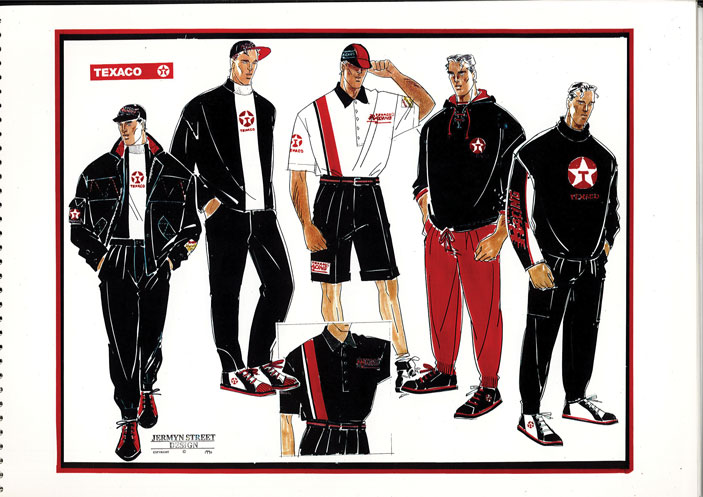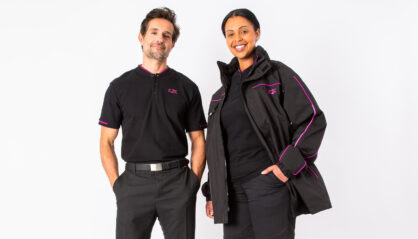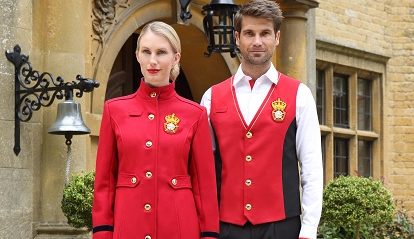Uniform Design Does Not have to be Timeless

From the excesses of the 80’s to the functional, global workwear needed today, JSD have been designing uniforms for top corporations for nearly 40 years.
In the early 80’s, it was still very rare to see designer uniforms, especially in the UK. Most employers bought cheaply made, off-the-shelf uniforms, often made from synthetic fabrics like crimplene and polyester. A badge, logo, crude colours and bad cutting were all that differentiated the uniform.
It was an era when “promotional” girls were widely used at trade shows and sporting events, and employers commonly specified dress size when recruiting for hospitality roles for women. There was very little in the way of consultation with staff.
From just adding a logo, to commissioning Armani, the 80’s saw major developments in uniform design
While the airline industry had been early to commission fashion designers to create their uniforms, by the late 80’s, this was becoming more prevalent across hospitality, retail and even the armed services got in on the act. Suddenly, we saw big name designers like Giorgio Armani designing uniforms for the Italian carabinieri (military police). As designer hotels became de rigueur, it was only natural that staff uniforms should complement the design aesthetic of these style palaces.
In the UK, JSD was at the forefront of this new approach to designer uniforms. Susanne Malim and her team, who had been working in fashion, were quick to spot an opportunity to be a modernising force in the industry and create bespoke corporate uniforms. Lamenting the dowdy and uncomfortable uniforms forced upon Britain’s workforce, Susanne had a vision of dressing working women in fabulous clothes that they’d be happy to wear off-duty.
Ditching the itchy polyester off-the-rack outfits of the 70’s, Malim and her team set to work introducing great style elements and better quality fabrics like innovative natural fabrics woven with stretch into client uniform designs. Taking inspiration from the Paris catwalks, popular culture and LA street style, JSD recognised that uniform was a powerful way to reflect a brand’s identity and convey brand messages.
“One of the most misunderstood elements of a successful uniform design is the idea that it has to be timeless. When I re-visited our archived designs of the 1980’s and 1990’s, I was reminded of how important being ‘in the moment’ is for some brands,” says Susanne for a recent Design Week article.

These Texaco uniforms were inspired by the street fashion of the day. With their big, bold logos, baggy cut, Lycra ski-wear shapes, cinched-in waists for the women, hooded tops, baseball caps, and trainers, this was practically the uniform of the late 80’s.

At the other end of the spectrum, JSD dressed hospitality workers at the Dunhill Golf Tournaments to impress. The team designed a wardrobe of smart, preppy uniforms, emphasised with shoulder pads, wide pants, double breasted suits and bold pinstripes.
After the effects of the economic recession, 90’s workwear reflected a more pared down, restrained period
When recalling fashion, some might argue that the 90’s were comparatively indistinct. The nouveau riche matured from flashy bling into a more tasteful and refined affluence. In the workplace, there was a more structured look with neutral colours when black became the norm for all fashion followers, as more women needed easy care, everyday office attire. Grunge and Britpop entered the lexicon, and with it, a devil-may-care approach to life and fashion. Charity shop buys were rebranded as vintage chic.
In the world of corporate workwear, more companies were wising up to the benefits of well-designed, custom uniforms. Branding became more discreet but nevertheless needed to be just as effective at reflecting brand values. The design process evolved too. Top uniform design houses incorporated more functionality, accommodating the wishes of the staff wearing them. More attention was paid to fabric selection, practical styles and designing a range of wardrobe items.
Health and safety, inclusivity and choice – Welcome to the 21st Century!
By the turn of the century, much had changed that affected uniform design. Health and safety regulations were tightened as were the HR laws governing what employers could expect of their staff. This required uniforms to meet certain PPE standards, and for workwear to be inclusive. No longer did staff have to fit into what employers provided but it had become incumbent on employers to provide a range of options to staff.
Businesses had gone global, meaning that bespoke uniform suppliers needed to cater their designs to a global workforce, taking into account regional differences in climate, customs, laws, and fashions. It also provided top bespoke uniform design companies like JSD with more opportunities to take their business international.
Flexibility, fabric technlogy, ethical design and changing fashions – taking staff uniforms into the future
Susanne Malim and her team have remained at the forefront of their industry for nearly 40 years, attracting a wide range of top corporations to work with them. They have done this by staying ahead of the game in creative design processes and fabric technology, and by adopting a flexible approach to clients. They have also taken a lead in promoting ethical and sustainable design. Just as importantly, JSD has invested in optimising production processes and has implemented best-in-practice supply chain management systems that their clients can rely on to optimise their brand and their budget.
To see recent examples of our work and how we put these design values into practice, do browse our Client Portfolios or get in touch if you’d like to talk through your own staff uniform plans.





